Making the Past Present with Light, Warmth and a High-Tech Gaze
San Diego, Calif., Feb. 19, 2015 — Late last year, two University of California, San Diego students set out for Florence, Italy, to diagnose a patient that had no prior medical record, couldn’t be poked or prodded in any way, and hadn’t been in prime condition for more than 800 years.
The ‘patient’ in question is the Baptistery of St. John, a basilica that sits in the Piazza del Duomo, adjacent to the famous Florence Cathedral (known colloquially as “The Duomo”). The students, structural engineering Ph.D. candidates Mike Hess and Mike Yeager of the Center of Interdisciplinary Science for Art, Architecture and Archaeology (CISA3), had been invited by the Museo dell’Opera del Duomo to conduct a structural 'health assessment' of the building, which was completed in 1128 and was the site where the Italian poet Dante and many other notable Renaissance figures were baptized.
Their resulting 3D digital model depicts a building that has aged gracefully, yet warrants careful and continued evaluation – not surprising considering the Baptistery has experienced several hundred years of settling and is situated in seismically active zone.
But there were indeed big surprises in store for the team, surprises that might have gone unnoticed were it not for the “high-tech gaze” of the advanced multi-spectral, high-resolution tools they used to see behind walls, underground and directly into the past.
Baptistery of San Giovani from CISA3 on Vimeo.
Warmth, light and history
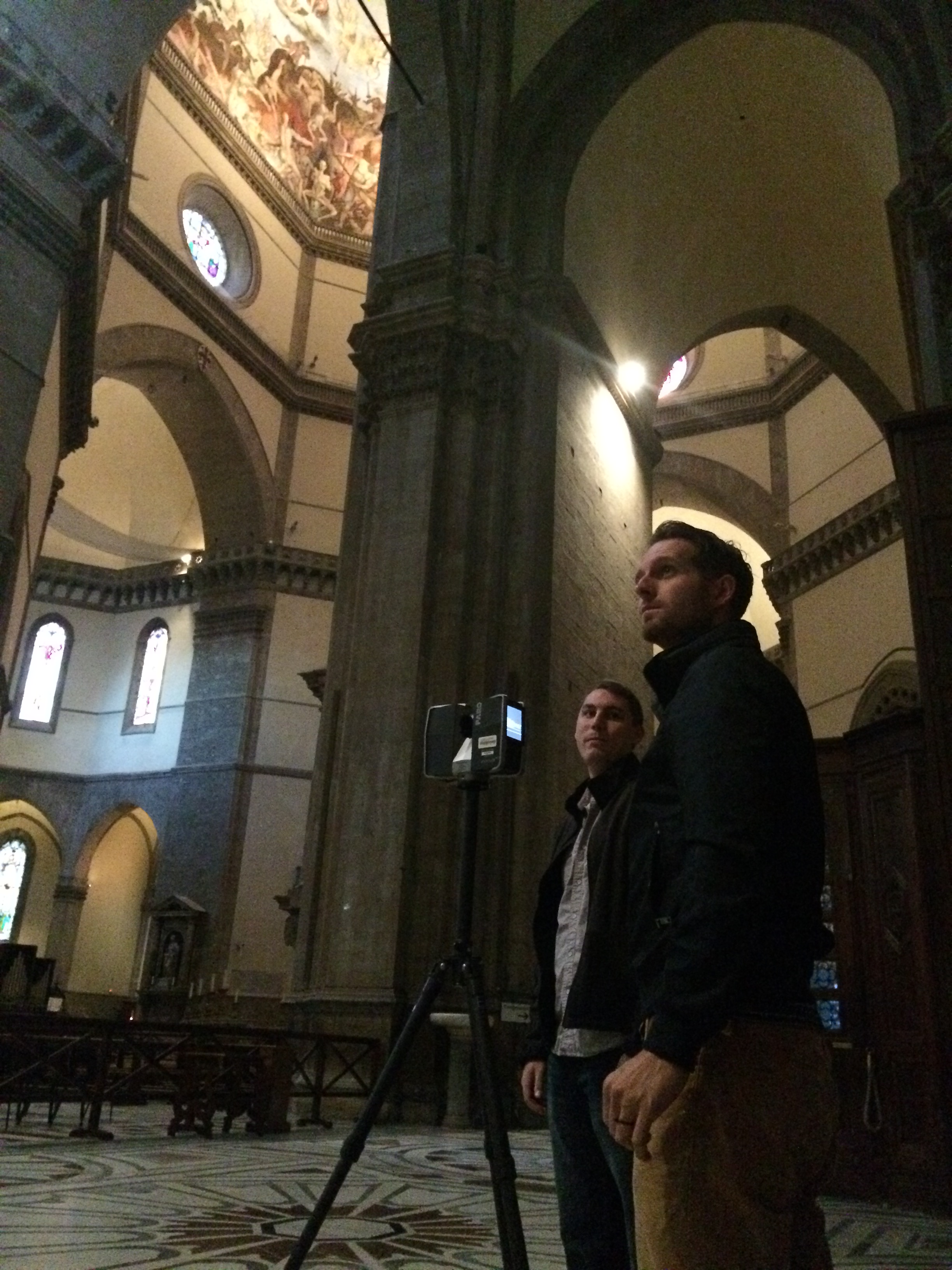
Before they could look into the past, the team’s first order of business was to create an accurate record of the Baptistery’s current condition.
Using LiDAR (light detection and ranging) laser scanning, ultra-high-resolution photography and thermal imaging techniques, Hess and Yeager constructed a comprehensive 3D model of the interior, exterior and facade of the 5,500 square foot Baptistery. The result includes stunningly realistic 3D models of the Baptistery, its marble sarcophagi and baptismal font, computed from thousands of photos using photogrammetry techniques. Those techniques are spatially referenced to the one and half billion 3D data points captured by the LiDAR scanner.
“This is a building constructed hundreds of years ago for which there are few original plans or drawings,” notes Yeager. “One of our goals was to create a record, which is an exact representation of the Baptistery as it stands today and will serve as a critical reference, tomorrow, next year or a hundred years from now.
“The point cloud data – taken from 80 LiDAR scans – becomes the geometric scaffold for the high-resolution thermal imagery,” Yeager continues. “The data can be projected into 3D space so we know exactly what we’re looking at spatially. The drawings are spatially accurate and we can now pull a measurement for any part of the building we want to look at, down to the millimeter.”
To obtain the thermal imagery, Hess built a custom mobile robotic thermal camera platform that captures thermal data at unprecedented resolution. These high-resolution images reveal, for example, that some of the tiles in the Baptistery’s mosaic ceiling – rumored to be the inspiration for Dante’s “Divine Comedy” – are separating from the structure in ways not yet visible to the naked eye.
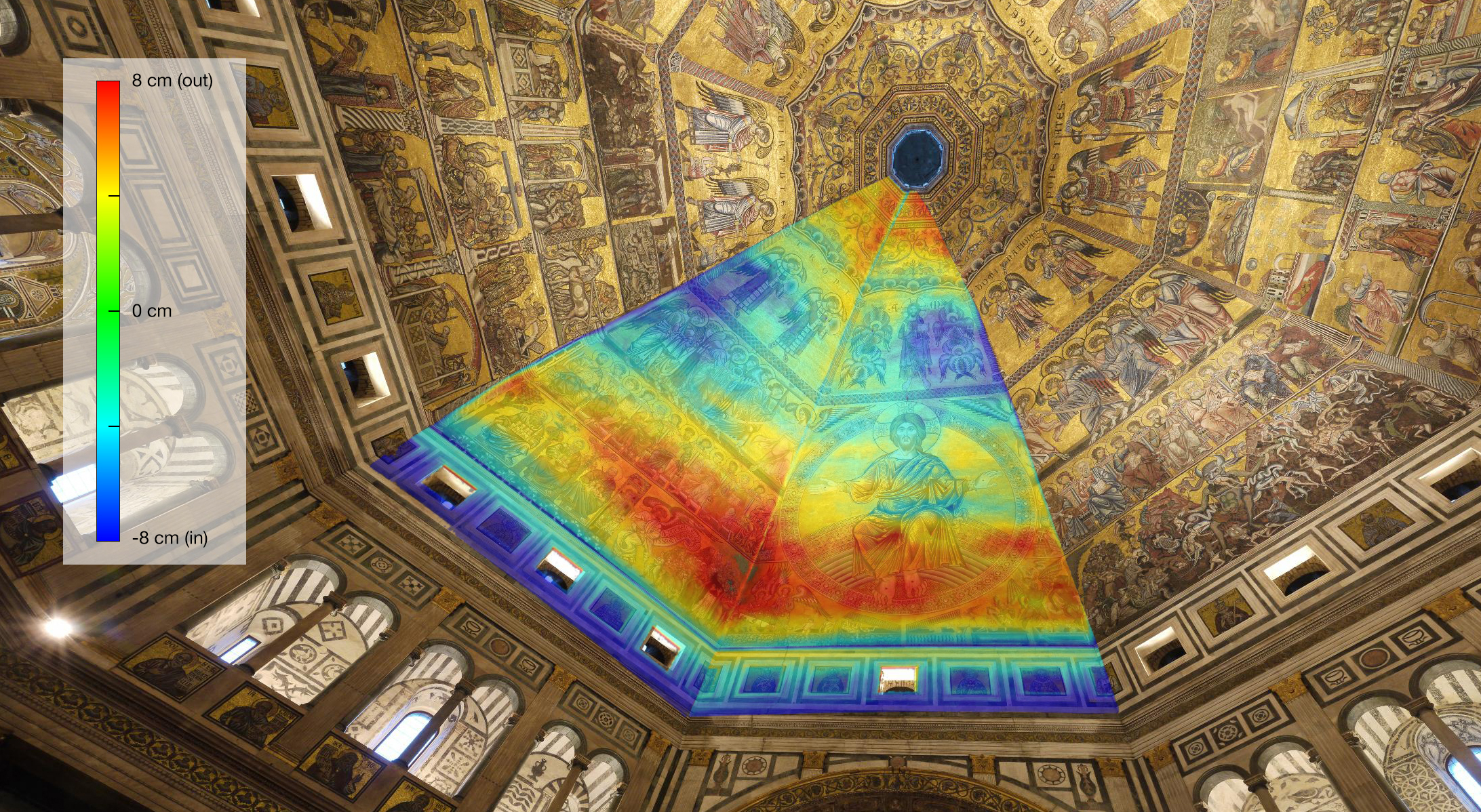
Adds Hess: “It essentially stitches many images together into a big mosaic of the structure at the level of detail we need to inspect it for structural flaws, see where areas have been restored or map areas of moisture and cracks.” Hess is also a scholar in the CISA3 Integrative Graduate Education and Research Traineeship (IGERT) program, supported by NSF, which prepares Ph.D. scientists and engineers from a variety of disciplines to solve complex research problems of scientific and societal significance at national and international levels.
Hess and Yeager’s work was funded by CISA3 (which is based at the UC San Diego Qualcomm Institute), as well as the National Science Foundation (NSF), the Friends of CISA3 and a grant from the UC San Diego Los Alamos National Lab Engineering Institute by way of the U.S. Department of Energy. It was preceded by previous imaging done by CISA3 researchers in collaboration with its long-term local partners from Editech and Geostudi Astier. Cultural heritage engineer Maurizio Seracini, who has provided CISA3 with a home base for its research activities in Florence for the better part of the past decade, also collaborated with the team.
Their resulting digital model, says CISA3 Director Falko Kuester, allows the viewer to “literally teleport to these places at photorealistic levels and to see what otherwise cannot be seen, revealing information critical for the understanding and long-term stewardship of this remarkable site.”
Adds Yeager: “A darker shade of marble might indicate, for example, that the slab was replaced. That’s not a structural application, but it builds out the history of the structure. It’s a way of seeing underneath the surface to get the true state of conservation of the structure.”
Getting to the bottom (and top) of it

Another of the team’s objectives was to take a more literal look underneath the surface of the building – right down into the dirt. Beneath the tiled floors of the Baptistery lie the ruins of a Roman temple built in the 4th or 5th century A.D., part of an ongoing excavation that began in the 1970s.
With the help of Seracini, Gianfranco Morelli from Geostudi Astier and IGERT-TEECH trainee and big-data visualization expert Vid Petrovic, Hess and Yeager used ground-penetrating radar to visualize, for the first time, an unexcavated portion of the ruins. Their data reveal what is hypothesized to be a staircase, two vaulted rooms and a series of walls and hallways.
“We’ve been able to visualize these ancient spaces in a way that’s never been done before,” says Yeager. “Now we’re able to use this technology to reference that data in space and ‘fly’ from the domed ceiling of the Baptistery down into the dirt to the ancient rooms beyond.”
In addition to the remarkable discovery of the Roman rooms, Hess and Yeager also determined from their scans that the floor above the excavation site differs dramatically from that above the unexcavated ruins – but not in the way one might expect.
“In the area that has been excavated, there now is a lot of open space, just air,” Yeager explains. “One would intuitively think the floor would be more prone to settling over the void space, but by analyzing the laser scanning data of the floor we see that’s not what’s happening.”
“There is a very dramatic drop in the vertical elevation of the floor, but it’s over the unexcavated portion,” Hess continues. “In the excavated area the floor of the Baptistery has been converted into a reinforced concrete slab, and we’re postulating that when concrete slab was placed over the excavation site, it over-stiffened that part of the structure, causing it to settle more slowly.”
Yeager holds up this counter-intuitive fact as an example of “the true power of diagnostic imaging techniques” that the CISA3 team is developing.
“These tools are allowing us to verify and validate what’s going on and provide answers we wouldn’t ordinarily be able to,” he says. “Now we can ‘fly’ around the model and visualize loading paths in a way that we could not by naked-eye inspection.”
Protecting and preserving the past
With the data from the Baptistery as a proof-of-concept baseline for doing large-scale structural health assessments, Yeager and Hess also got permission to capture data from the Baptistery’s larger and more well-known neighbor, the Duomo.
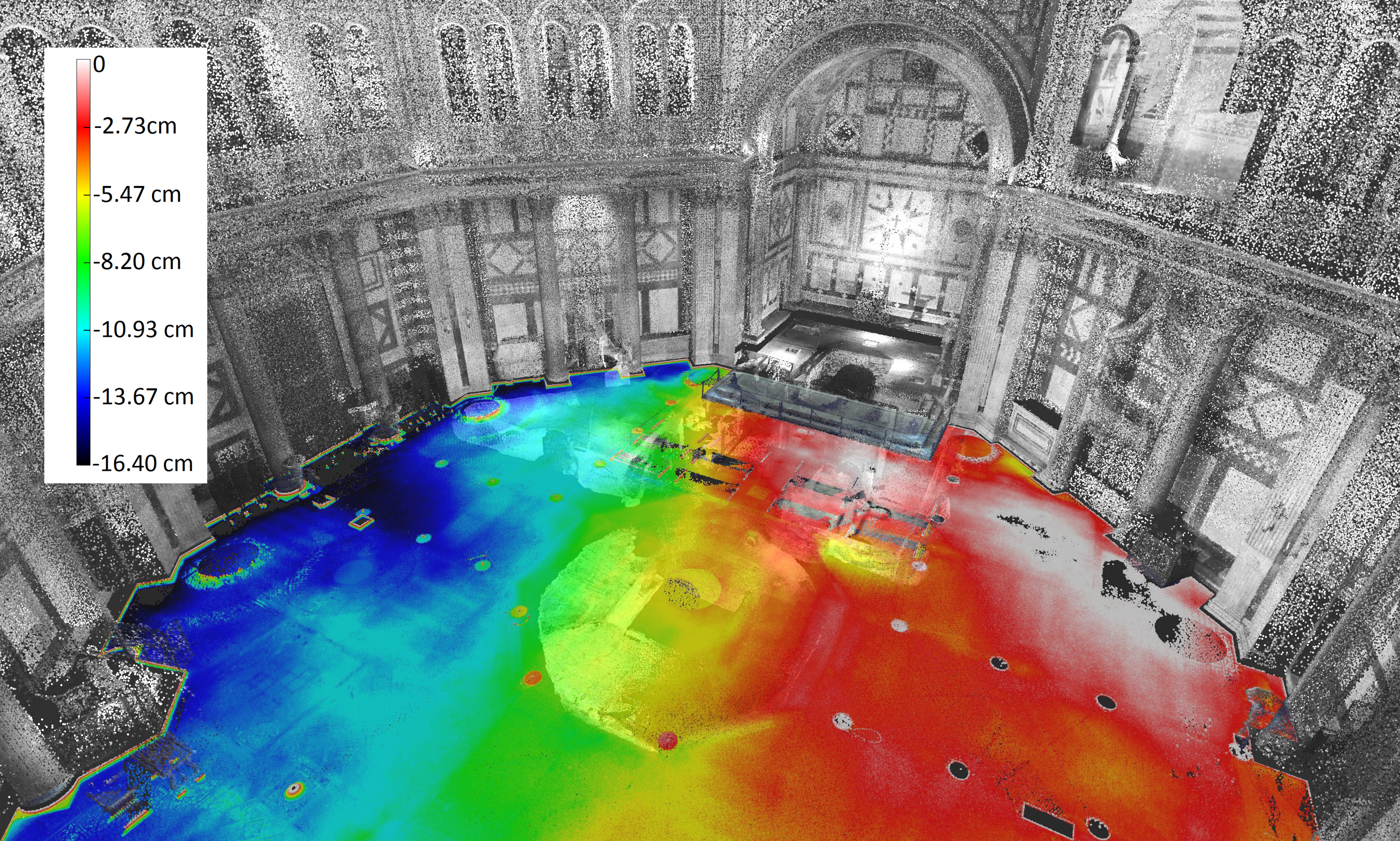
Says Hess: “The Baptistery was the testbed for the methodology, but the Duomo is a huge structure, and we want to set the foundation for documenting it. We’ve proven that this is the way to do it and now we can expand it and go bigger.”
With the data they captured from the Duomo (which required standing in the precarious far side of the plexiglass that keeps tourists from falling to their deaths), Hess and Yeager created a digital model of the dome, as well as the space between the two shells of the Dome that contains a staircase tourists climb to overlook the city from its highest point.
With 3D data they’d captured at the Baptistery, they measured structural deviations from an idealized curvature of the cathedral’s dome.
“This kind of measurement gives us an idea of how the dome is surviving,” Yeager explains. “We can see from the laser scanning analysis that the weight of the dome is causing an outward thrust at the bottom. For years, people have speculated this, but we were able to actually quantify it and visually show that there’s a definite eight centimeter bulge.”
“Our ultimate goal,” he continues, “is to take a structure and discretize it into a bunch of little bitty pieces to build a numerical model. We can then load the structure any way we like and use modeling techniques to determine real forces and stresses that are being absorbed by the structure. We could have a model of the Baptistery or the Duomo – structures susceptible to earthquakes – and see how these buildings would respond in real life, which could help us to design a potential retrofit.”
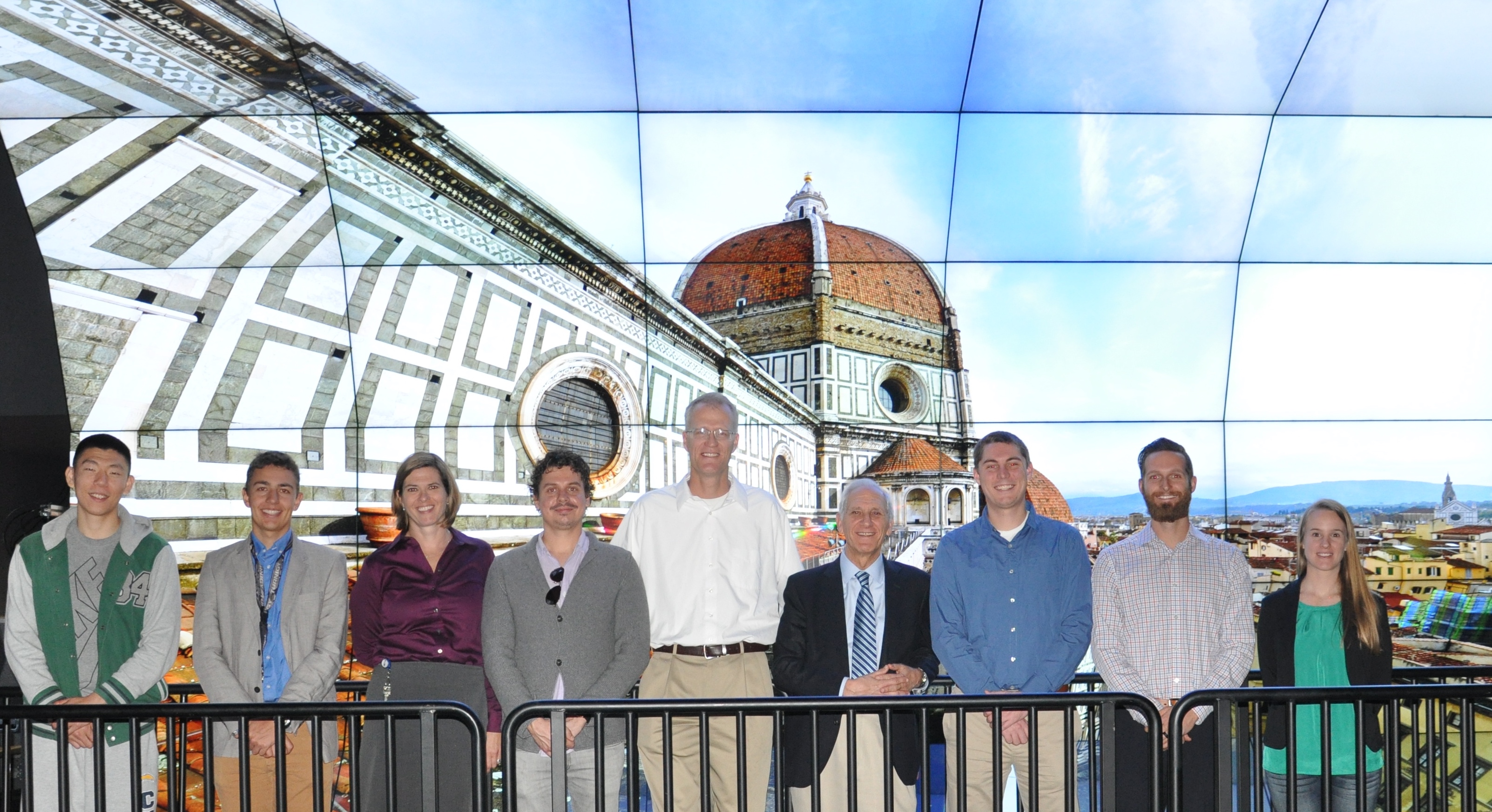
Franco Lucchesi, president of Opera Del Duomo Firenze, recently visited CISA3 in San Diego to see the data that the team obtained come to life in its advanced visualization environments, including the WAVE, a 70 megapixel resolution virtual reality environment that provides an unprecedented degree of presence (the feeling of ‘being there’). Remarking that CISA3’s cultural heritage engineering methodology is uniquely positioned to provide important insights into the understanding and preservation of these monuments, Lucchesi invited the UC San Diego team to further expand its collaboration with the Opera Del Duomo.
“Being invited to work at this remarkable site – while bringing stakeholders, researchers, practitioners and the public together in pursuit of ‘creating a future for the past ’ through science and engineering – is truly a privilege,” says Kuester. “The diverse, interdisciplinary and highly professional student teams working on this and other CISA3 projects are our pride and joy.”
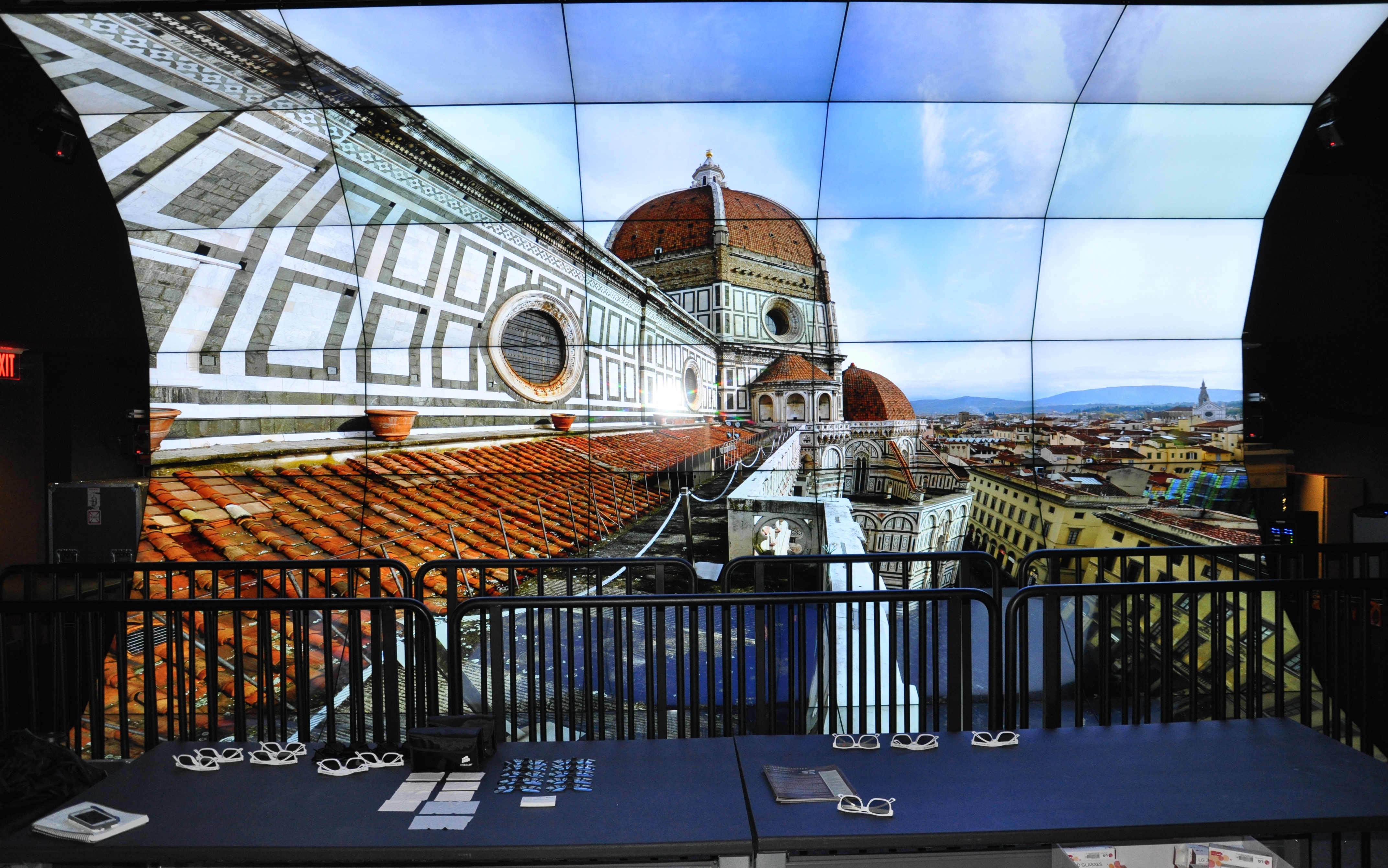
In the meantime, Hess and Yeager say the opportunity to play even a small role in this important conservation effort is an honor and a privilege.
“The feeling of walking in with the lights off, having the place to yourself, being in this giant amazing space – it never gets old,” says Hess.
“These structures are monuments of what human beings can create,” adds Yeager. “They are stunning and gorgeous and beautiful. Being able to play a small part in potentially conserving these timeless jewels of human craftsmanship is time really well spent.”
Related Links
Media Contacts
Tiffany Fox, (858) 246-0353, tfox@ucsd.edu
